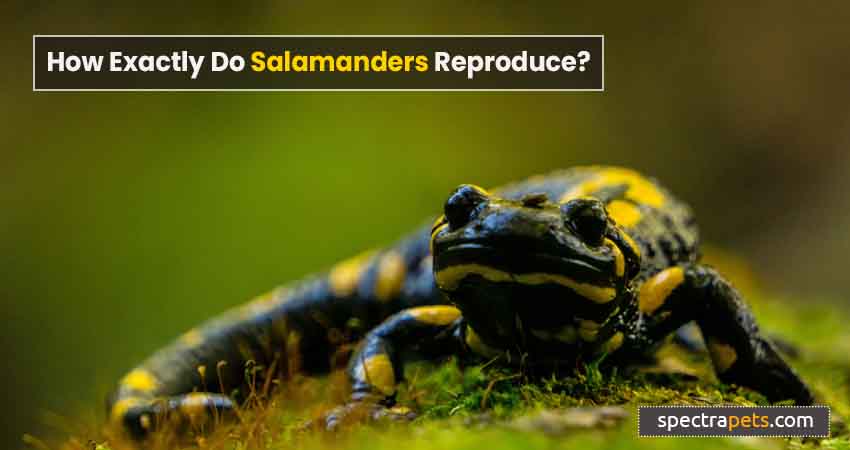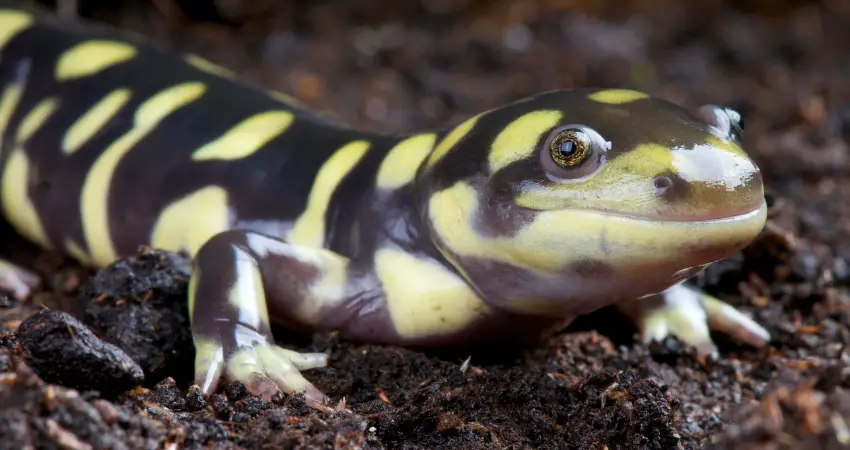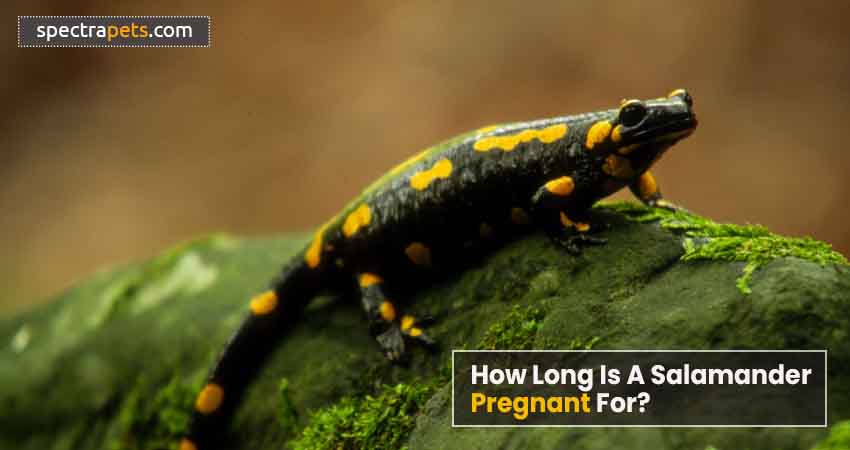One of the most important aspects of pet ownership is knowing everything about it. That not only includes their food habits, sleeping patterns, and moods, but also reproduction. Take it from me, I had a hard time controlling my cat because of how frequently it was giving birth.
It’s easier to know these things for a dog or a cat, even maybe fish. But something rare like a salamander joins the discussion and there’s suddenly not enough information out there. So how do salamanders reproduce? Depending on the species, it could be either sexual or asexual reproduction. Even the frequency of producing babies is different.
But don’t be disheartened, I’ve got more than just a one-liner. Here’s everything you need to know about your cute salamander’s reproductive abilities…
How Exactly Do Salamanders Reproduce?
Different species of salamanders have different ways in which they can reproduce. Below, I have explained various methods of salamander reproduction:

External Fertilization
External fertilization is a common reproductive strategy among salamanders, and it involves the release of eggs and sperm into the water, where fertilization occurs outside of the female’s body. This method of reproduction is seen in species such as newts, spiky salamanders, and mudpuppies.
During the breeding season, males will release a chemical called pheromones into the water, which attracts females. The male will then use his claspers, which are modified hind legs, to hold onto the female and release his sperm. The female will then release her eggs, which are fertilized by the male’s sperm.
The fertilized eggs are then left to develop on their own, either in the water or on land, depending on the species. Some salamander species lay their eggs in nests or protective structures, while others lay them directly on the ground or in the water.
External fertilization is a relatively simple and efficient way for salamanders to reproduce, and it allows for a large number of offspring to be produced in a short period of time. It is also advantageous because it allows the eggs to develop in a more stable and nutrient-rich environment, increasing the chances of survival for the offspring.
Direct Development
Direct development is a reproductive strategy seen in some salamander species, including lungless salamanders and many tropical species. This method of reproduction involves the eggs developing directly into miniature versions of the adult, bypassing the larval stage.
In species that reproduce through direct development, the female will lay her eggs in a protected location, such as in a nest or on a damp leaf. The females lay their eggs on land or in water, depending on the species. The female will then guard the eggs until they hatch, at which point the young salamanders emerge as miniature versions of the adult.
One advantage of direct development is that it allows the young to emerge as fully-formed, independent animals, rather than going through a vulnerable larval stage. This can increase their chances of survival, as they are able to forage for food and defend themselves from predators from the moment they hatch.
Another advantage of direct development is that it allows salamanders to reproduce in environments where there may be limited resources or poor conditions for larval development. This can be especially important for tropical species, which may live in environments with frequent droughts or other environmental challenges.

Neoteny
Neoteny is a reproductive strategy seen in some salamander species, including the axolotl. Neoteny refers to the retention of larval characteristics into adulthood, and it means that these salamanders are able to reproduce while still in their larval form.
In species that reproduce through neoteny, the young are able to reproduce as soon as they reach sexual maturity, without undergoing metamorphosis into an adult form. This is in contrast to most salamander species, which go through a larval stage followed by metamorphosis into an adult form before they are able to reproduce.
One advantage of neoteny is that it allows salamanders to reproduce at a younger age, potentially increasing the chances of survival for the offspring. It also allows salamanders to reproduce in environments where resources may be limited, as they do not need to undergo the energy-intensive process of metamorphosis.
However, neoteny also has some drawbacks. For example, salamanders that reproduce through neoteny may have reduced physical abilities compared to adults, as they do not undergo the changes that come with metamorphosis. This can make them more vulnerable to predators.
Parthenogenesis (Asexual Reproduction)
Parthenogenesis is a rare but interesting reproductive strategy seen in some salamander species. This is a form of asexual reproduction that is seen in some salamander species, including the Chinese giant salamander. In parthenogenesis, the female is able to produce offspring without the need for fertilization by a male.
In species that reproduce through parthenogenesis, the female is able to produce eggs that develop into viable offspring without fertilization. This can occur through various mechanisms, such as the activation of the female’s eggs by environmental or hormonal stimuli, or through the duplication of the female’s genetic material.
One advantage of parthenogenesis is that it allows salamanders to reproduce in environments where there may be a limited number of males present. It also allows for the rapid production of offspring, as there is no need for the time-consuming process of finding a mate and mating.
However, there are also some drawbacks to parthenogenesis. For example, offspring produced through parthenogenesis are genetically identical to the female, which can lead to reduced genetic diversity within a population. This can make the population more vulnerable to disease and other environmental challenges.
Do Salamanders Have Asexual or Sexual Reproduction?

How exactly do you think salamanders breed? Do they require both a male and a female?
Salamanders are a diverse group of amphibians, and they have a wide range of reproductive strategies. Some salamanders reproduce sexually, while others reproduce asexually.
Sexual reproduction is the most common method of reproduction among salamanders, and it involves the production of offspring through the fusion of eggs and sperm from two individuals. This can occur through various mechanisms, such as external fertilization (where eggs and sperm are released into the water and fertilization occurs outside of the female’s body) or internal fertilization (where fertilization occurs inside the female’s body).
Asexual reproduction, on the other hand, involves the production of offspring without the need for fertilization by a male. This can occur through various mechanisms, such as parthenogenesis (where the female’s eggs develop into offspring without fertilization) or neoteny (where the young are able to reproduce as soon as they reach sexual maturity, without undergoing metamorphosis into an adult form).
But how often do these amphibians reproduce? Find out more in the next section.
How Often Do Salamanders Reproduce?

Again, the frequency of mating in salamanders varies depending on the species and the environmental conditions. In general, salamanders tend to mate seasonally, with most species mating during the spring or early summer.
The specific frequency of mating within a given breeding season also varies depending on the species. Some salamanders may mate multiple times during a single breeding season, while others may only mate once.
In addition to the breeding season, some salamanders may also mate at other times of the year if the environmental conditions are favorable. For example, some species may mate in the fall if there are adequate water levels or if there has been sufficient rainfall.
Can Salamanders Reproduce Internally?

Yes, some salamanders do reproduce through internal fertilization, which involves fertilization occurring inside the female’s body. This is in contrast to external fertilization, which involves the release of eggs and sperm into the water, where fertilization occurs outside of the female’s body.
Internal fertilization is seen in a variety of salamander species, including many terrestrial (land-dwelling) species such as the lungless salamanders and many tropical and aquatic species. In these species, the male will use his claspers, which are modified hind legs, to hold onto the female and transfer his sperm directly into her reproductive tract. The eggs are then fertilized inside the female’s body and develop into larvae.
Internal fertilization has several advantages for salamanders. For example, it allows the female to have more control over the fertilization process and to choose a mate that is genetically compatible. It also allows the eggs to develop in a more stable and nutrient-rich environment, increasing the chances of survival for the offspring.
When Do Salamanders Become Sexually Mature?

At what age do salamanders gain the ability to mate and breed? Again, it is varied among the numerous salamander species.
Salamanders reach sexual maturity at different ages depending on whether they reproduce sexually or asexually.
For species that reproduce sexually, the age at which they reach sexual maturity tends to vary widely. Some species may become sexually mature at a relatively young age, while others may not reach sexual maturity until they are several years old. Factors that can influence the age at which salamanders reach sexual maturity include the species’ lifespan, rate of growth, and environmental conditions such as temperature and food availability.
In terms of species that reproduce asexually, the age at which they reach sexual maturity may also vary. In some cases, salamanders that reproduce through asexual methods such as parthenogenesis or neoteny may be able to reproduce as soon as they reach sexual maturity without undergoing metamorphosis into an adult form.
How Long Is A Salamander Pregnant For?

It is not accurate to use the term “pregnant” to describe the reproductive process in salamanders, as this term is specific to mammals. Salamanders, like all amphibians, reproduce through a process called fertilization, in which eggs are fertilized by sperm to produce offspring.
The length of time that it takes for salamander eggs to develop and hatch into larvae can vary depending on the species and the environmental conditions. Some species may have relatively short incubation periods, with eggs hatching within a few weeks or months. Other species may have longer incubation periods, with eggs taking several months or even a year to hatch.
Factors that can influence the length of the incubation period in salamanders include the species’ rate of development, the temperature of the environment, and the availability of food and other resources.
Do Salamanders Give Live Birth?

Yes, some salamanders do give live birth. However, it is not true for all salamanders. Some salamanders lay eggs, while others give birth to live young.
Salamanders that lay eggs include most species of the family Plethodontidae, which are known as lungless salamanders.
Other salamanders, such as those in the family Salamandridae, which includes the fire salamander, give birth to live young. These salamanders are known as viviparous, meaning that they give birth to fully developed young rather than eggs. The young are born fully formed and resemble smaller versions of their parents.
Read More: Why Are Salamanders Associated With Fire?
Wrapping Up
I bet that was a thrilling read. But hey! You got to learn a lot, didn’t you? I certainly didn’t know this much before I started researching it, so I can definitely guarantee that you’ve learned something new today.
Hopefully, this will take you one step closer to becoming the best salamander owner out there. Good luck.
